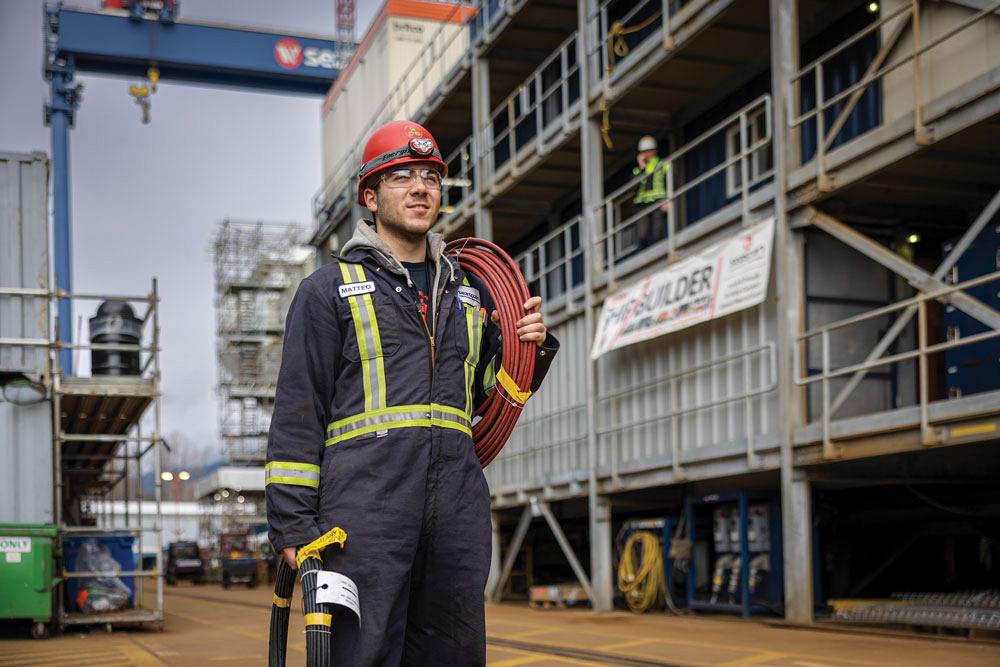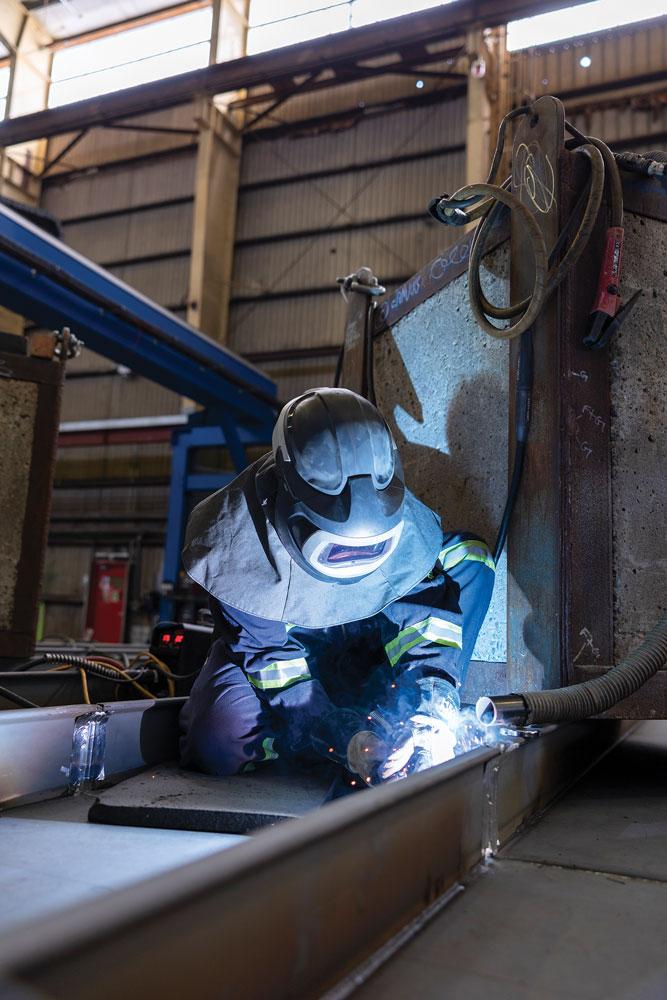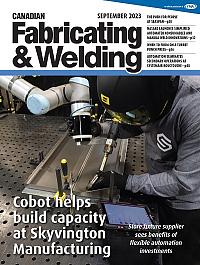Editor
- FMA
- The Fabricator
- FABTECH
- Canadian Metalworking
The push for people at Seaspan
Recruitment a full-time job for busy North Vancouver shipyard
- By Rob Colman
- October 6, 2023
- Article
- Management

With the development of the National Shipbuilding Strategy, younger tradespeople at Seaspan are able to see a future full of promise and stability with the resurgence of shipbuilding in British Columbia. Photos: Seaspan
Finding tradespeople is a struggle that a number of industry sectors are facing today. When you’re an operation that requires hundreds of tradespeople from a variety of specialties, this struggle is only exacerbated. Dan Southern, director, workforce development at Seaspan’s Vancouver Shipyards, explained how his company is trying to meet that challenge during a recent presentation at the Metalworking & Manufacturing Expo in Langley, B.C. earlier this year.
Market Position
Southern noted that one of the challenges Seaspan must address is the surplus of other construction projects underway in B.C., including Site C dam and the Coastal GasLink pipeline (among 15 or more others).
“Those other projects require thousands of tradespeople,” he noted. “And it is no secret that around the world there is a big wave of retirement of people who have been in the trades a long time, with a big gap behind them where not as many people were getting into the trades. It is expected that 85,000 job openings in the skilled trades are expected from now through to 2031. In B.C., we have a lower rate of unemployment for people in construction and in trades than we do in an already low unemployment scenario in B.C.”
Seaspan’s Vancouver Shipyards’ workforce has increased from 389 in 2011 to more than 2,200 in 2023—more than 1,300 of those are tradespeople. Despite the recruitment challenge, the company’s goal is to hire 500 or more new skilled tradespeople to meet operational plans in 2023. While recruitment is a constant process, the company had hired more than 400 tradespeople—more than halfway to meeting their target hiring goal—as of early August.
The question they continue to ask themselves is how can they make themselves stand out among all of the other companies hiring skilled tradespeople?
Recognition
The biggest challenge out of the gate for such a large organization is creating an understanding of Seaspan’s scope of work.
“If you look at the pipeline of other large infrastructure projects, there are many similar type projects under construction in the province or elsewhere in Canada,” said Southern. “Shipbuilding on this scale, however, is a unique business that fewer people are familiar with. Part of the goal of coming to events like MM Expo is to tell our story so people better understand who we are and what we do and how they may fit into that work.”
Curb Appeal
One way that Seaspan has tried to stand out from some of the other competing job opportunities in the market is emphasizing the long-term nature of the work it is doing and its location.
“We are local to the Lower Mainland,” said Southern. “You get to go home to your family every night. You don’t have to fly in and fly out and be away from your family for ages. We are also offering long-term careers. Because the National Shipbuilding Strategy is scheduled to last beyond 2040, we want people to know that there is stability and they do not need to go from project to project.
“The appeal of that security is helping to draw some people to us, certainly,” Southern continued. “When you are young, camp work can be profitable and a fun adventure. But once you start raising a family, a steady base starts to be more appealing.”

The search is on for many types of trades at Seaspan, but hiring welders is the greatest need right now.
Training
Seaspan has had to be more flexible with the people it is hiring to increase its numbers, and they have dedicated themselves to training people internally to meet their needs.
“For instance, ideally we want to hire steamfitters, but we’ve hired a number of Red Seal plumbers and are training them to do that work,” said Southern. “Similarly, we’ve taken auto techs and developed them to do the mechanical work we’ll require on the ships.”
The company now has a dedicated electrical training space, where every newly hired electrician goes through a week of training to learn specific work that is required for the ships currently under construction.
Seaspan opened its Welding Centre of Excellence in 2021, which has made it possible to train incoming talent and ensure that its welders, fitters, and anyone else required to do any welding work have the skill set to get the job done.
The company encourages recruitment through the various unions that operate at the shipyards, and currently has 96 active apprentices at the Vancouver Shipyards through that effort.
“Our Victoria Shipyards has 92 apprentices, all managed through the trade development team,” said Southern. “Apprentices are the future. They allow us to make sure that those youngsters coming into the trades, whichever trade it might be, are familiar with what we need specifically.”
A total of 48 apprentices graduated at Seaspan last year. “We really push them to get through that training so that we can have them at the Red Seal level and in our shipyards as a full tradesperson.”
Strategic Advertising
Because its potential hiring pool is so varied, Seaspan has taken a multipronged approach to its advertising, some of it more precisely targeted than others.
“We’ve used traditional and social media,” said Southern. “There’s no secret in recruitment. I can’t give you some remedy that’s going to make it easy to find tradespeople. But there is a lot of new technology coming into the recruitment space that we are trying. For instance, geotagging locations via various social media platforms and targeting people to see our ads based on their location or particular trade designations on their profiles. This sort of technology allows you to specifically target certain demographics, and we have seen the number of applications rise as a result.”
The key is to get the opportunities in front of the right people. The company is continuing to improve its external communications to match these advertising initiatives. It also has advertised its push for increased diversity in the shipyards to encourage more women and indigenous tradespeople and apprentices.

Seaspan’s Fire Brigade is just one example of the company’s commitment to employee safety and wellness.
Promoting Health and Safety
Although health and safety may not be the first thing potential employees think of when considering a job, Vancouver Shipyards is demonstrating its commitment to continuous improvement in this area as well. It has reduced its lost-time injury frequency by 40 per cent, going from 3.73 injuries per 200,000 hours in 2015 to 1.77 in 2022.
It’s also ISO 45001- and WorkSafeBC COR-certified, has a full health and safety training program, and maintains an on-site medical clinic with a nurse practitioner.
In addition, it has on-site fire response capabilities through Seaspan’s Initial Response Fire Brigade, and it is donating a mock vessel to the District of North Vancouver Fire and Rescue Service (DNVFRS) for use in training.
Seaspan has unique challenges in its search for new tradespeople, but much of what they are doing to attract that talent can serve as a lesson to others.
Lessons such as the importance of telling the story of your business well, the value of training people in-house, and committing to the health and safety of your team will help make you an attractive place to work, no matter what industry sector you serve. The competition for talent will be fierce in coming years. Use everything you can to show how you stand out. Tell your story and share your value proposition with the right audiences.
Editor Robert Colman can be reached at rcolman@fmamfg.org.
Seaspan Vancouver Shipyards, www.seaspan.com
About the Author

Rob Colman
1154 Warden Avenue
Toronto, M1R 0A1 Canada
905-235-0471
Robert Colman has worked as a writer and editor for more than 25 years, covering the needs of a variety of trades. He has been dedicated to the metalworking industry for the past 13 years, serving as editor for Metalworking Production & Purchasing (MP&P) and, since January 2016, the editor of Canadian Fabricating & Welding. He graduated with a B.A. degree from McGill University and a Master’s degree from UBC.
subscribe now


Keep up to date with the latest news, events, and technology for all things metal from our pair of monthly magazines written specifically for Canadian manufacturers!
Start Your Free Subscription- Trending Articles
Aluminum MIG welding wire upgraded with a proprietary and patented surface treatment technology

Achieving success with mechanized plasma cutting

Hypertherm Associates partners with Rapyuta Robotics

Brushless copper tubing cutter adjusts to ODs up to 2-1/8 in.

Gema welcomes controller

- Industry Events
MME Winnipeg
- April 30, 2024
- Winnipeg, ON Canada
CTMA Economic Uncertainty: Helping You Navigate Windsor Seminar
- April 30, 2024
- Windsor, ON Canada
CTMA Economic Uncertainty: Helping You Navigate Kitchener Seminar
- May 2, 2024
- Kitchener, ON Canada
Automate 2024
- May 6 - 9, 2024
- Chicago, IL
ANCA Open House
- May 7 - 8, 2024
- Wixom, MI















